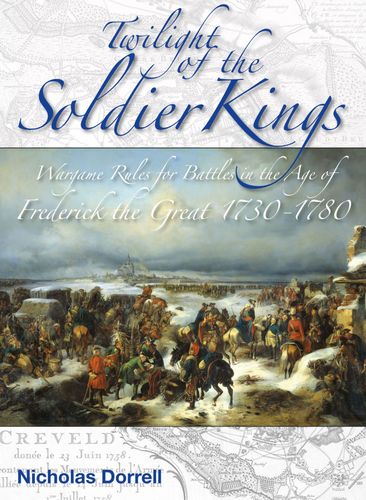|
Advertisement
|
Twilight of the Soldier Kings: Wargame Rules for the Battles in the Age of Frederick the Great 1730-1780

DescriptionThe Twilight of the Soldier Kings rules is a set designed to fight large historical battles on a reasonable sized table and with a reasonable number of figures in the era of Fredereick the Great (1730 to 1770). The player is the army commander seeking to marshal the full forces that their historical counterpart had to achieve victory and not some colonel or brigadier controlling a few battalions or squadrons in the fight for some sector of a battlefield. The concentration is on the 'big picture' rather on relatively unimportant details. The rules reward historic tactics and practices while making typical 'gamer' tactics obsolete. So, players will want their forces to be in at least two lines with a reserve and not strung out in a line as is commonly done in other rules. The system is intuitive and easy to pick up. The units are around 2,500 infantry, around 1,200 cavalry and 12 to 20 guns and so the units are often a brigade of around 4 infantry battalions or 8 to 12 cavalry squadrons. The scale is flexible with all distances, ranges, movements based on half of the frontage of the units you use. For example, if your units have a frontage of perhaps 100mm (4 inches) the standard measurement unit in the game will be 50mm (2 inches). There is no figure removal so you can base you units as you wish, with any number or size of figures on a base, etc. As long as the units are the same frontage it does not matter and indeed neither does it if the armies involved are based differently. While any unit size can be used if the frontage of a unit is in the region of 120mm then most battles can be fought on a table 1.8m by 1.2m (6 feet by 4 feet) or similar. Most standard battles should be playable in a typical afternoon or evening playing session. It is possible to play 'Manoeuvre' battles in which the attacker has extra options to attack but will usually require a larger table. In a standard battle the armies are on table in their half of the table and generally facing up to each other. While in a manoeuvre battle the defending army is in active and placed in the centre of the table with a wide area empty of troops around them. The attacking army can then attempt to march around the defending army to attack from one or more different directions. Alternatively the attacking army can arrive on table in sections from all edges of the table in a converging attack. Of course these manoeuvres might not work or can be delayed or the inactive defenders can activate and react to the situation. The rules include scenarios for the battles of Mollwitz (1741), Kolin (1757), Krefeld (1758) and a generic Manoeuvre battle based on the battles of Hochkirch and Zorndorf (both 1758). —description from the publisher Game DiscussionsAdd CommentYou need to be logged in to comment. Insert Bullet List Please enter at least one item. Item: Item: Item: Item: Item: Insert Numeric List Please enter at least one item. Item: Item: Item: Item: Item: Insert Link Please enter the link of the website Optionally you can add display text Insert Email Please enter the email address Optionally add any display text Insert Image Please enter the link of the image Insert YouTube Video Please enter the link of the video Marketplace | ||||

Comments (0)